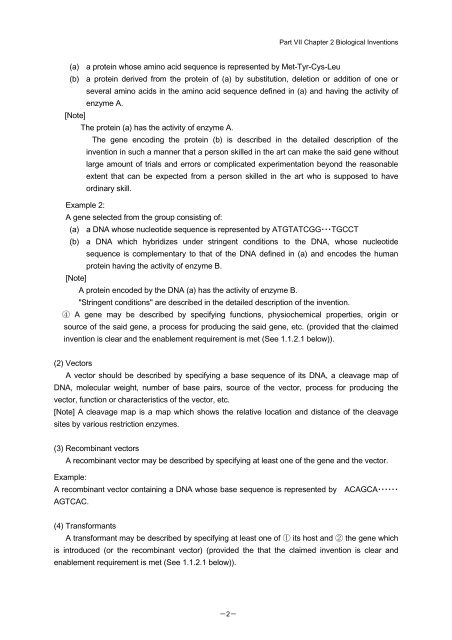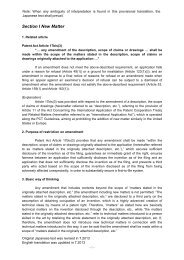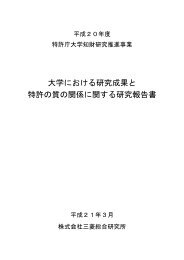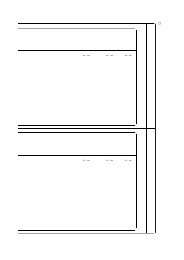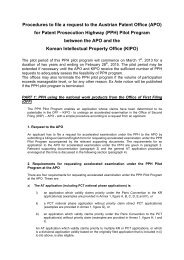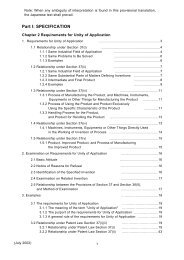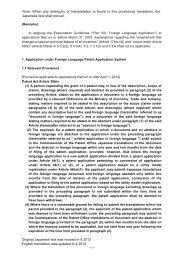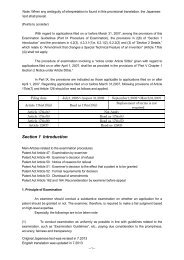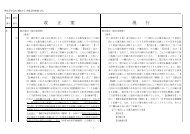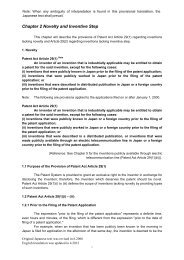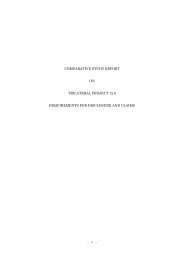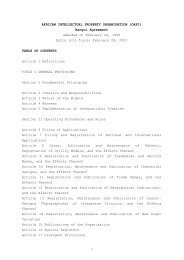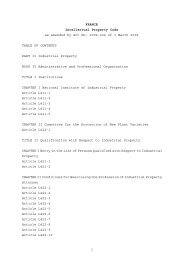Chapter 2 Biological Inventions - Japan Patent Office
Chapter 2 Biological Inventions - Japan Patent Office
Chapter 2 Biological Inventions - Japan Patent Office
Create successful ePaper yourself
Turn your PDF publications into a flip-book with our unique Google optimized e-Paper software.
Part VII <strong>Chapter</strong> 2 <strong>Biological</strong> <strong>Inventions</strong><br />
(a) a protein whose amino acid sequence is represented by Met-Tyr-Cys-Leu<br />
(b) a protein derived from the protein of (a) by substitution, deletion or addition of one or<br />
several amino acids in the amino acid sequence defined in (a) and having the activity of<br />
enzyme A.<br />
[Note]<br />
The protein (a) has the activity of enzyme A.<br />
The gene encoding the protein (b) is described in the detailed description of the<br />
invention in such a manner that a person skilled in the art can make the said gene without<br />
large amount of trials and errors or complicated experimentation beyond the reasonable<br />
extent that can be expected from a person skilled in the art who is supposed to have<br />
ordinary skill.<br />
Example 2:<br />
A gene selected from the group consisting of:<br />
(a) a DNA whose nucleotide sequence is represented by ATGTATCGG・・・TGCCT<br />
(b) a DNA which hybridizes under stringent conditions to the DNA, whose nucleotide<br />
sequence is complementary to that of the DNA defined in (a) and encodes the human<br />
protein having the activity of enzyme B.<br />
[Note]<br />
A protein encoded by the DNA (a) has the activity of enzyme B.<br />
"Stringent conditions" are described in the detailed description of the invention.<br />
4 A gene may be described by specifying functions, physiochemical properties, origin or<br />
source of the said gene, a process for producing the said gene, etc. (provided that the claimed<br />
invention is clear and the enablement requirement is met (See 1.1.2.1 below)).<br />
(2) Vectors<br />
A vector should be described by specifying a base sequence of its DNA, a cleavage map of<br />
DNA, molecular weight, number of base pairs, source of the vector, process for producing the<br />
vector, function or characteristics of the vector, etc.<br />
[Note] A cleavage map is a map which shows the relative location and distance of the cleavage<br />
sites by various restriction enzymes.<br />
(3) Recombinant vectors<br />
A recombinant vector may be described by specifying at least one of the gene and the vector.<br />
Example:<br />
A recombinant vector containing a DNA whose base sequence is represented by ACAGCA・・・・・・<br />
AGTCAC.<br />
(4) Transformants<br />
A transformant may be described by specifying at least one of 1 its host and 2 the gene which<br />
is introduced (or the recombinant vector) (provided the that the claimed invention is clear and<br />
enablement requirement is met (See 1.1.2.1 below)).<br />
-2-


